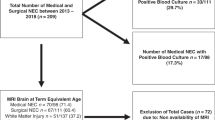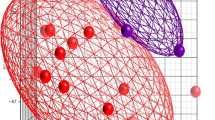Abstract
Very low birth weight (VLBW) infants with suspected late-onset infection requiring sepsis screening were enrolled in a prospective study to evaluate the diagnostic utilities of a comprehensive panel of key chemokines and cytokines, both individually and in combination, to identify diagnostic markers for early recognition of bacterial sepsis and necrotizing enterocolitis (NEC). Plasma chemokines interleukin (IL)-8, interferon-γ–inducible protein 10 (IP-10), monokine induced by interferon-γ (MIG), monocyte chemoattractant protein 1 (MCP-1), growth-related oncogene-α (GRO-α), and regulated upon activation of normal T cell expressed and secreted (RANTES) and cytokines IL-1β, IL-6, IL-10, IL-12p70, and tumor necrosis factor α (TNF-α) were measured at the onset of sepsis (0 h) and 24 h later. Of 155 suspected infection episodes, 44 were classified as infected. Concentrations of all studied inflammatory mediators (except IL-1β and RANTES) were significantly higher in the infected than in the noninfected group at 0 h, but the levels decreased precipitously by 24 h. IP-10 with a plasma cutoff concentration ≥1250 pg/mL could identify all septicemic and NEC cases and had the highest overall sensitivity (93%) and specificity (89%) at 0 h. We conclude that preterm infants have the ability to induce a robust chemokine and cytokine response during sepsis, and IP-10 is a sensitive early marker of infection.
Similar content being viewed by others
Log in or create a free account to read this content
Gain free access to this article, as well as selected content from this journal and more on nature.com
or
Abbreviations
- CRP:
-
C-reactive protein
- GRO-α:
-
growth-related oncogene-α
- IP-10:
-
interferon-γ–inducible protein 10
- MCP-1:
-
monocyte chemoattractant protein 1
- MIG:
-
monokine induced by interferon-γ
- NEC:
-
necrotizing enterocolitis
- RANTES:
-
regulated upon activation of normal T cell expressed and secreted
- ROC:
-
receiver operating characteristics
- VLBW:
-
very low birth weight
References
Stoll BJ, Hansen N, Fanaroff AA, Wright LL, Carlo WA, Ehrenkranz RA, Lemons JA, Donovan EF, Stark AR, Tyson JE, Oh W, Bauer CR, Korones SB, Shankaren S, Laptook AR, Stevenson DK, Papile LA, Poole WK 2002 Late-onset sepsis in very low birth weight neonates: the experience of the NICHD Neonatal Research Network. Pediatrics 110: 285–291
Stoll BJ, Hansen NI, Adams-Chapman I, Fanaroff AA, Hintz SR, Vohr B, Higgins RD National Institute of Child Health and Human Development Neonatal Research Network 2004 Neurodevelopmental and growth impairment among extremely low birth-weight infants with neonatal infection. JAMA 292: 2357–2365
Ng PC, Wong HL, Lyon DJ, So KW, Liu F, Lam RK, Wong E, Cheng AF, Fok TF 2004 Combined use of alcohol hand rub and gloves reduces the incidence of late onset infection in very low birthweight infants. Arch Dis Child Fetal Neonatal Ed 89: F336–F340
Siu YK, Ng PC, Fung SC, Lee CH, Wong MY, Fok TF, So KW, Cheung KL, Wong E, Cheng AF 1998 Double blind, randomised, placebo controlled study of oral vancomycin in prevention of necrotising enterocolitis in preterm, very low birthweight infants. Arch Dis Child Fetal Neonatal Ed 79: F105–F109
Schultz C, Temming P, Bucsky P, Göpel W, Strunk T, Härtal C 2004 Immature anti-inflammatory response in neonates. Clin Exp Immunol 135: 130–136
Ng PC, Cheng SH, Chui KM, Fok TF, Wong MY, Wong W, Wong RP, Cheung KL 1997 Diagnosis of late onset neonatal sepsis with cytokines, adhesion molecules, and C-reactive protein in preterm very low birthweight infants. Arch Dis Child Fetal Neonatal Ed 77: F221–F227
Ng PC 2004 Diagnostic markers of infection in neonates. Arch Dis Child Fetal Neonatal Ed 89: F229–F235
Ng PC, Lam HS 2006 Diagnostic markers for neonatal sepsis. Curr Opin Pediatr 18: 125–131
Cavaillon JM, Adib-Conquy M, Fitting C, Adrie C, Payen D 2003 Cytokine cascade in sepsis. Scand J Infect Dis 35: 535–544
Luster AD 1998 Chemokine-chemotactic cytokines that mediate inflammation. N Engl J Med 338: 436–445
Maghazachi AA 2000 Intracellular signaling events at the leading edge of migrating cells. Int J Biochem Cell Biol 32: 931–943
Ghosh S, Latimer RD, Gray BM, Harwood RJ, Oduro A 1993 Endotoxin-induced organ injury. Crit Care Med 21: S19–S24
Marchant A, Alegre ML, Hakim A, Pierard G, Marecaux G, Friedman G, De Groote D, Kahn RJ, Vincent JL, Goldman M 1995 Clinical and biological significance of interleukin-10 plasma levels in patients with septic shock. J Clin Immunol 15: 266–273
van Dissel JT, van Langevelde P, Westendorp RG, Kwappenberg K, Frolich M 1998 Anti-inflammatory cytokine profile and mortality in febrile patients. Lancet 351: 950–953
Miller EJ, Cohen AB, Nagao S, Griffith D, Maunder RJ, Martin TR, Weiner-Kronish JP, Sticherling M, Christophers E, Matthay MA 1992 Elevated levels of NAP-1/interleukin-8 are present in the airspaces of patients with the adult respiratory distress syndrome and are associated with increased mortality. Am Rev Respir Dis 146: 427–432
Gogos CA, Drosou E, Bassaris HP, Skoutelis A 2000 Pro- versus anti-inflammatory cytokine profile in patients with severe sepsis: a marker for prognosis and future therapeutic options. J Infect Dis 181: 176–180
Ng PC, Li K, Wong RP, Chui K, Wong E, Li G, Fok TF 2003 Proinflammatory and anti-inflammatory cytokine responses in preterm infants with systemic infections. Arch Dis Child Fetal Neonatal Ed 88: F209–F213
Hodge G, Hodge S, Haslam R, McPhee A, Sepulveda H, Morgan E, Nicholson I, Zola H 2004 Rapid simultaneous measurement of multiple cytokines using 100 μL sample volumes-association with neonatal sepsis. Clin Exp Immunol 137: 402–407
Rossi D, Zlotnik A 2000 The biology of chemokines and their receptors. Annu Rev Immunol 18: 217–242
Alam R 1998 Chemokines in the biology of cell movement and inflammation. In: Middleton E Jr, Reed CE, Ellis EF, Adkinson NF Jr, Yunginger JW, Busse WW (eds) Allergy: Principles and Practice. Mosby, St. Louis, pp 124–136
Ng PC, Li K, Wong RP, Chui KM, Wong E, Fok TF 2002 Neutrophil CD64 expression: a sensitive diagnostic marker of late-onset nosocomial infection in very low birthweight infants. Pediatr Res 51: 296–303
Walsh MC, Kliegman RM, Fanaroff AA 1988 Necrotizing enterocolitis: a practitioner's prospective. Pediatr Rev 9: 219–226
Ng PC, Li G, Chui KM, Chu WC, Li K, Wong RP, Chik KW, Wong E, Fok TF 2004 Neutrophil CD64 is a sensitive diagnostic marker for early-onset neonatal infection. Pediatr Res 56: 796–803
Ng PC, Li K, Leung TF, Wong RP, Li G, Chui KM, Wong E, Cheng FW, Fok TF 2006 Early prediction of sepsis-induced disseminated intravascular coagulation with interleukin-10, interleukin-6, and RANTES in preterm infants. Clin Chem 52: 1181–1189
Sullivan SE, Staba SL, Gersting JA, Hutson AD, Theriaque D, Christensen RD, Calhoun DA 2002 Circulating concentrations of chemokines in cord blood, neonates, and adults. Pediatr Res 51: 653–657
Fotopoulos S, Mouchtouri A, Xanthou G, Lipsou N, Petrakou E, Xanthou M 2005 Inflammatory chemokine expression in the peripheral blood of neonates with perinatal asphyxia and perinatal or nosocomial infections. Acta Paediatr 94: 800–806
Dufour JH, Dziejman M, Liu MT, Leung JH, Lane TE, Luster AD 2002 IFN-γ-inducible protein 10 (IP-10; CXCL10)–deficient mice reveal a role for IP-10 in effector T cell generation and trafficking. J Immunol 168: 3195–3204
Kopydlowski KM, Salkowski CA, Cody MJ, van Rooijen N, Major J, Hamilton TA, Vogel SN 1999 Regulation of macrophage chemokine expression by lipopolysaccharide in vitro and in vivo. J Immunol 163: 1537–1544
Frangogiannis NG, Mendoza LH, Smith CW, Michael LH, Entman ML 2000 Induction of the synthesis of the C-X-C chemokine interferon-γ-inducible protein-10 in experimental canine endotoxemia. Cell Tissue Res 302: 365–376
Møller AS, Bjerre A, Brusletto B, Joø GB, Brandtzaeg P, Kierulf P 2005 Chemokine patterns in meningococcal disease. J Infect Dis 191: 768–775
Ng PC 2005 Clinical trials for evaluating diagnostic markers of infection in neonates. Biol Neonate 87: 111–112
Ng PC, Lam CW, Li AM, Wong CK, Cheng FW, Leung TF, Hon EK, Chan IH, Li CK, Fung KS, Fok TF 2004 Inflammatory cytokine profile in children with severe acute respiratory syndrome. Pediatrics 113: e7–e14
Author information
Authors and Affiliations
Additional information
This project was supported by a direct grant of research awarded by the Research Grant Council of the Government of Hong Kong SAR (project code 2041147) and by the H. M. Lui Memorial Fund (Providence Foundation Limited) (project code 6901814).
Rights and permissions
About this article
Cite this article
Ng, P., Li, K., Chui, K. et al. IP-10 Is an Early Diagnostic Marker for Identification of Late-Onset Bacterial Infection in Preterm Infants. Pediatr Res 61, 93–98 (2007). https://doi.org/10.1203/01.pdr.0000250207.95723.96
Received:
Accepted:
Issue date:
DOI: https://doi.org/10.1203/01.pdr.0000250207.95723.96
This article is cited by
-
Inflammation, sepsis severity and neurodevelopmental outcomes of late-onset sepsis in preterm neonates
Pediatric Research (2023)
-
Prediction of acute kidney injury, sepsis and mortality in children with urinary CXCL10
Pediatric Research (2022)
-
Prospective multicentre study of host response signatures in neonatal sepsis in Sub Saharan Africa
Scientific Reports (2022)
-
Serum CXCL10/IP-10 may be a potential biomarker for severe Mycoplasma pneumoniae pneumonia in children
BMC Infectious Diseases (2021)
-
Risk-stratification of febrile African children at risk of sepsis using sTREM-1 as basis for a rapid triage test
Nature Communications (2021)



